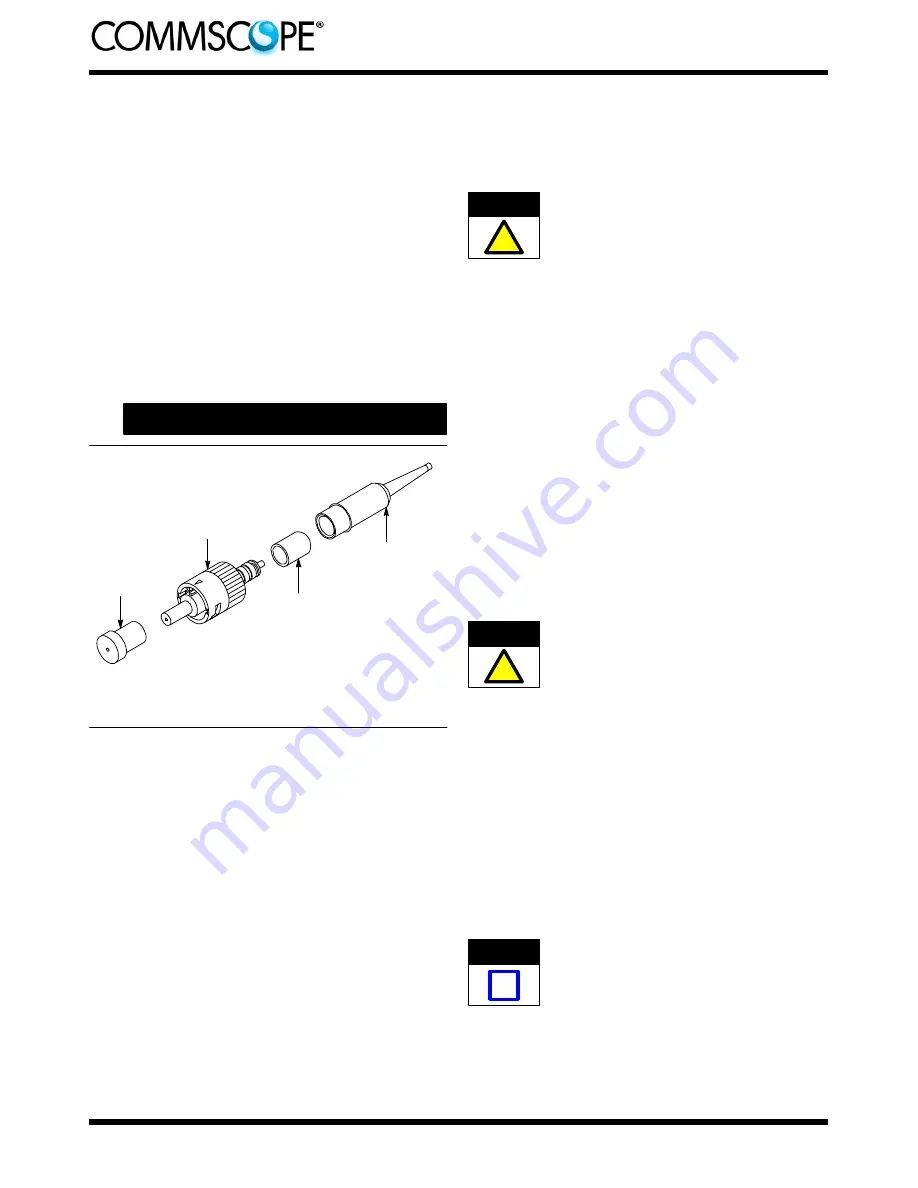
408- 4457
Rev
J
2
of 16
4. REQUIRED TOOLS AND MATERIALS
— Cable Holder Assembly 492703--1
— Miller Strip Tool 1754708--1
— Scissors 501014--1 (for jacketed cable only)
— Alcohol Fiber Wipe Packet 501857--2
— isopropyl alcohol
— Fiber Optic Cleaver 1871696--1 (408--10086)
— LightCrimp Plus ST Die Set with Crimping Tool
492623--1 (consists of Die Set 492622--1 and
PRO--CRIMPER® III Hand Tool 2064431--1)
5. ASSEMBLY PROCEDURE
5.1.
900-
m
m Bare Buffered Fiber
Kit Components Required
(Discard Other Components)
Connector
Assembly
Bare Buffer
Boot
Plunger
Protective
Cap
Connector kit is shipped with these installed onto connector
assembly. Keep them in place until ready for assembly.
Ferrule
Protective
Cover
A. Preparing 900-
m
m Bare Buffered Fiber
(Figure 2)
1. Slide the bare buffer boot (small diameter end
first) over the buffer. See Figure 2, Detail A.
2. Remove the ferrule protective cover and the
plunger protective cap from the connector
assembly. Keep the cover; discard the cap.
3. Push the connector into the holder of the cable
holder assembly with the ferrule protective cover
facing outward. See Figure 2, Detail B. Make sure
that the connector butts against the lip of the arm
of the cable holder. Slide the fiber into the channel
marked “BUFFER” on the cable holder. Make sure
that the tip of the buffer butts against the end of the
channel.
4. Mark the buffer at each cross--slot of the
channel. See Figure 2, Detail B. Remove the buffer
from the cable holder.
5. Using the strip tool, strip the fiber to the first
mark. It is recommended holding the strip tool at
an angle to the fiber and stripping the fiber in three
sections. See Figure 2, Detail C. Clean the fiber
with an alcohol fiber wipe to remove the fiber
coating residue.
Before using the strip tool, make sure that the “V”
opening is clean; otherwise the fiber could break.
Only use isopropyl alcohol on the tool.
B. Cleaving
(Figure 3)
1. Open the fiber clamp of the fiber optic cleaver.
Press the button, and slide the carriage back
(toward the fiber clamp). Then move the fiber slide
back until it stops.
2. Place the stripped fiber into the slot so that the
end of the buffer is at the 8--mm marking. See
Figure 3, Detail A.
3. While applying pressure on the buffer, carefully
slide the fiber slide forward (toward the carriage)
until it stops. See Figure 3, Detail B.
4. Gently close the fiber clamp, and slide the
carriage forward. DO NOT touch the button while
sliding the carriage. See Figure 3, Detail C.
5. Open the fiber clamp, and move the fiber slide
back until it stops.
6. Remove the cleaved fiber, and properly dispose
of the scrap fiber.
DO NOT attempt to clean the fiber after it has
been cleaved.
C. Crimping
(Figures 4 and 5)
1. Open the cable clamp of the cable holder, and
hold the buffer (with the cleaved end offi ber facing
the connector) inside the clamp. Pull the end of the
fiber even with the front of the arm of the cable
holder, and holding the buffer in place, close the
clamp. See Figure 4, Detail A.
2. Carefully insert the fiber into the plunger of the
connector assembly until the fiber bottoms against
the internal fiber. Make sure that the remaining
mark on the buffer enters the plunger. The
resultant bend in the buffer should hold the fiber
against the internal fiber. See Figure 4, Detail B.
It is important that the fiber bottoms against, and
remains against, the internal fiber. If the mark
does not enter the plunger or if the fiber does not
seem to bottom against the internal fiber, the
fiber may be caught on internal guides. Rotating
the connector and backing the fiber out a small
amount and re--entering may help. However, if
the mark will not enter the plunger, the fiber must
be re--stripped.
CAUTION
!
CAUTION
!
NOTE
i


































